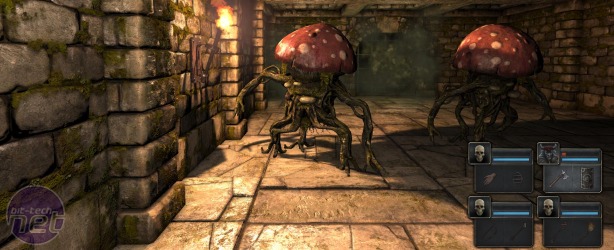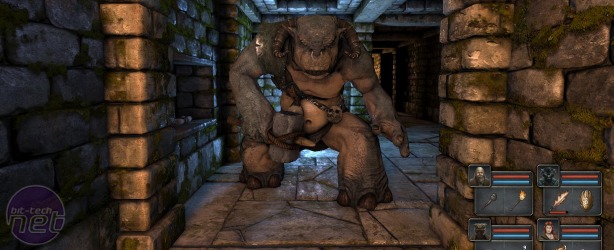
The Legend of Grimrock
As if the promise of an Old-School Mode wasn't enough, Grimrock also commits utterly to some of the more esoteric and tactical quirks of the genre to great affect. Your party of four characters travels in a 2x2 grid, for example, and while you can rearrange their places in that grid you're unable to shift them to another formation. They travel as a unit, not a line.The implication of this is that you have various fronts as a result of their arrangement; only the two characters at the fore of the group can attack enemies with melee weapons. The others, at the back, need polearms, ranged or magic weapons in order to influence the battle - but that's only assuming you're directly facing the conflict. Get flanked or attacked from behind and the relevant members of your party will be damaged instead.
Combat itself is mostly pretty straightforward in Grimrock, thanks to an excellently designed and utterly uncluttered UI. Weapons and held items appear directly beneath character portraits and merely by right-clicking on these can you issue an order to attack, followed by a cool-down period that depends on how skill that character is with that weapon. Enemies behave in a rhythm which matches your own options and, while there's sadly no option to switch combat to a totally turn-based mode, the regular pace means battles only rarely get seriously stressful.
The only exception to this is with the magic system, which seems to have been deliberately designed to be as stressful and time-consuming as possible - in a good way.
Magic works differently to regular combat, you see. Rather than causing a mage to attack with his hands, right-clicking with a wizard summons a small 3x3 grid of arcane sigils. Here you need to enter in a code for the spell you want, followed by the casting button - but get it wrong and you'll miscast.
The result of this is that using magic is not only that spells are slower than melee attacks, but that they require more skill to use too - which is what magic is supposed to be within the fiction. The reward is that magic attacks usually cause more damage and that spells have more flexibility than physical attacks, but the downside is the fact that they require more dexterity and management to use effectively. Having more than one wizard in your group becomes a major hassle, we discovered - but the magic system is so compelling that it's definitely worth trying!
Away from the design choices, Grimrock is graphically stunning too as a benefit of its limitations. There's no huge open areas to render, so attention has instead been ploughed into a decent lighting system and detailed textures that look fantastic when the graphics are pushed to the maximum.
That said, even if Legend of Grimrock had terrible, sprite-based graphics then we'd still argue that it's an excellent game that deserves your cash. It's simply one of the most staggeringly faithful and compelling revivals of the genre that we've ever seen, proving challenging and engaging in ways that few other games do.
As it is though, Grimrock isn't ugly or sprite based - so we can say all that and then add that it looks pretty too.

-
Airflow95 / 100


MSI MPG Velox 100R Chassis Review
October 14 2021 | 15:04











Want to comment? Please log in.